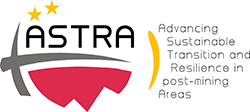La Escucha Mining Museum
40º 47' 14'' N 0º 48' 46'' E
Escucha, Teruel, Aragón
Spain
Description
La Escucha mine was one of the most productive coal mines in Spain.
Extracted Materials
Coal
Antropological info
La Escucha village has an important archaeological Iberian site. There are remains of houses, walls made out of irregular masonry and adobe, as well as Iberian ceramic vases. These materials were found in an isolated hill of 1184 metres altitude. There are Iberian ceramics like bowls, basins, kalathos decorated with geometrical designs.
Sociologal info
The mine had two different periods. In the 70s, the mine reached its heyday, as the coal exportations gained importance due to an oil crisis. This era is also called “The Second Golden Ages of Coal”. From the middle 80s onwards, decadence began. Spain entered the EU, which had as a consequence the acceptance of European energy plans, as well as CO2 restrictions.
The coal high sulphurs concentration forced the mine to desulphurize the lignite, in order to reduce the pollutant emission levels. This led to a capital investment incrementation. The government stopped helping underground mines in favour of the opencast mining (which did not need as much workers or as much investment in security, and was more productive). The mine closure occurred in 1992.
Archaeological info
The Pilar Well mine was built 1968, and it’s a 360 metres vertical extraction mine with two different levels: the first one located at a 162 metres depth and the second one at a 195 metres depth.
The Castillete is 52 metres tall and weighs 350 tons. It is a tower-shaped metallic structure used for extraction operations. Inside the Castillete we can see mining hopper where coal was deposited, that lead to the conveyor belt that transported the ore to La Eschucha Thermal Power Plant.
Sustainable tourism insights
In 1960, local stores, restaurants and business could barely cope with the 400 mine workers that lived in the village with their families. The mine closure led to emigration, and the village was sentenced to isolation. In 2002, the remaining neighbours found the solution. They created La Escucha Mining Museum, that protected the Industrial Mining Heritage. They also conditioned Se Verá mine (actual museum) for tourism and made it visitable.
La Escucha Mines are the only one in Spain with an open coal pit visitable, and one of the two in Europe.
Environment sustainability
With the mine closure, the environmental pollution ceased. The village and mines were conditioned for tourism, making the mines a cultural attraction. Thus, the mines that once were a contamination source are now a museum that makes profit for the village and mines sustainability.
Creativity insights/curiosities
In the entrance of the mine, there was a board where lots of keys were held.
Each worker had his key, so at the end of the day everyone could know who was missing thanks to the missing keys.









